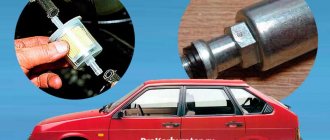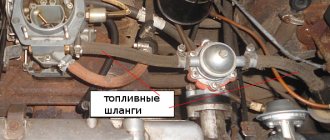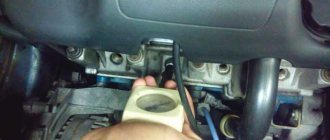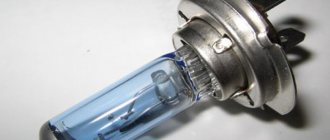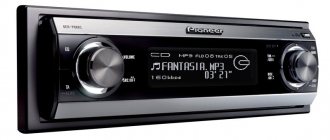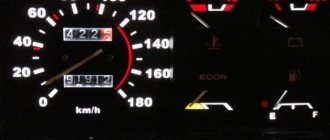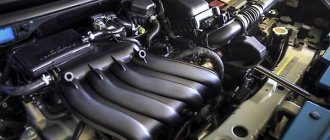3.8/5 — (61 votes)
You need to know how to set the idle speed of the VAZ 2106 in order to adjust the carburetor. You can perform this procedure quite quickly with your own hands, if, of course, you have an idea of what a carburetor consists of and the functions of its main components. But first things first, let's start with the saddest thing - the case when suddenly there is no idle speed and the engine starts to stall.
It doesn't matter where you are, at what point! It is important that the program for a small car service is always at hand! And wherever you are, information about business processes and spare parts sales is available. Live easier!
You'll be lucky if this happens close to home. But if you’re on the road, it’s not good enough. On my own behalf, I’ll add that several times I had to remove and disassemble the carburetor while standing on a narrow highway, shying away from passing trucks and highlighting it with a flashlight. A good habit is to take a thermos and a flashlight on the road.
Unstable operation of the injection engine
Usually expressed in a spontaneous change in engine speed. Observed while driving and at idle. The most common reason for low speed in VAZ2107/2105 injection units is the failure of the mass air flow sensor (mass air flow sensor).
This device controls the amount of air entering the engine. Based on this data, the ECU regulates the supply of a combustible mixture with the optimal fuel-to-air ratio under different engine operating modes. Accordingly, in the absence of this balance, engine speed begins to depend on the amount of incoming oxygen. That is, the wind blew - the speed increased, the speed died down - it decreased.
It is quite simple to make sure that it is the mass air flow sensor that is faulty. Disconnect the device connector and the ECU will switch to emergency mode. In this mode, fuel supply is controlled by the throttle position. If the car begins to behave more adequately, then the MVR is faulty. You can drive like this, but the power will drop slightly and fuel consumption will increase.
A failed mass air flow sensor cannot be repaired, except for contamination, so you can try to clean it.
Cleaning algorithm for DMVR VAZ2107/2105:
- Remove the sensor along with the protective casing.
- Unscrew the two screws and pull the sensor out of the base without touching the surfaces of the active element (straight, bent wire).
- Wash the casing with any dishwashing liquid.
- Using a bottle of cleaner for DMVR or for carburetor, based on alcohols (without acetone), carefully clean the surfaces.
- Pour generously 3-4 times, the liquid should drain.
- Dry the device.
- Reassemble the block in reverse order.
Read more about why the engine vibrates at idle
The most common cause of engine vibration is, in fact, its tripling, that is, uneven operation of a group of cylinders. It is for this reason that the load on the crankshaft will likely be distributed unevenly, and the engine will begin to seem to move from side to side. Since the frequency of its operation is high, strong vibrations will begin to be felt. Vibrations are the first indicator that the engine is malfunctioning and needs to be checked urgently. Second indicator: steering wheel vibration. Third indicator: a noticeable drop in power, the appearance of dips when accelerating.
A very well-known problem: improper mounting of the engine, resulting in vibrations. As a rule, we are talking about installing low-quality cushions that wear out quickly, or cushions and fasteners made of different materials. You can identify the problem in pairs: one person monitors the engine, and the other controls the operation of the unit from the cabin. Please note that there should be a slight deflection of the unit . If it “squints” in one direction especially strongly, then that’s where the pillow was badly worn.
A much rarer cause of vibration is the different mass of parts included in the cylinder-piston group. Surely every car enthusiast knows that engine parts must have not only a strictly defined shape, but also weight, or rather, the weight of a group of components must be the same. So, when selecting new pistons, you need to monitor their weight. If the difference is small, then, as a last resort, some of the metal can be removed from the non-working surface of the pistons - they will become lighter.
A very rare problem: improper operation of the fuel system and fuel contamination. Regarding the first: individual components of the fuel system may be contaminated, which ultimately affects the combustion of the fuel-air mixture. As for the second: the ingress of water into the fuel is guaranteed to provoke rapid coking of the cylinders, and only then the appearance of vibrations.
An even rarer reason: a large load on the generator. This is true for small cars where the throttle is controlled by an electronic throttle. As a rule, vibrations are observed during simultaneous operation of heated seats, mirrors, glass, as well as when the headlights and stove are working. Typically, the driver can feel engine vibrations after stopping the car.
Why does the engine stall when it is hot, and a well-warmed engine does not start?
1. The first possible reason is the carburetor. During movement, a large amount of air passes through it, due to which the carburetor is seriously cooled, at the same time the fuel that passes through it is also cooled. As a result, the carburetor temperature is several times lower than the engine temperature. Because of this feature, problems arise; after a long journey, you turn off the engine and make a short stop, at which time the carburetor begins to get very hot from the hot engine body. The remaining gasoline in the float chamber begins to evaporate from the high temperature, filling the voids - the air filter, the intake manifold and the carburetor itself. Air pockets form, and not a drop of fuel remains in the float chamber.
The solution to the problem is quite simple - press the gas pedal halfway several times and try to start the engine. This will make the mixture leaner and release excess evaporation. It should be noted that problems with hot starting can also be due to a similar problem, only due to the fault of the fuel pump or fuel line. This usually happens in hot weather when air pockets form from evaporation in the fuel system or pump, preventing fuel from entering the carburetor.
2. The second possible reason for the strange behavior of a warm engine is problems with the starter. Make sure that when you try to start the engine, the starter turns and does not just click or not respond at all. If this is the case and one of the above options is confirmed. the starter needs to be checked. If you are on the road, then the check can be reduced to a basic check of the starter power wire or other visual operations. If you get home, perform a detailed check of the starter according to these instructions. In case of malfunction, repair or replace it.
3. Alternatively, the reason when the engine does not start when hot may be a dead battery due to the reason described above, when the generator did not charge and the battery was completely dead.
Well, it seems like you didn’t miss anything!? That’s all for today, we hope the article will help, tell you the cause of the breakdown and help you solve your problem. If you know other reasons, as well as ways to solve them, you can supplement the article using the comment form
Thank you for your attention
Common reasons why the idle stalls:
1. The most common one is the idle speed regulator (sensor), which is directly related to engine idle speed. It’s quite easy to check whether there is a breakdown. If the car does not start when you turn the starter, operate the gas pedal, the engine should start. If the revs start to fluctuate immediately after you take your foot off the pedal, there is a 99% chance that the reason is in the idle speed control. The solution is to replace the idle air control; this will take VAZ owners a minimum of time.
2. The second probable reason why the engine stalls at idle is problems with the throttle valve. This problem can be cured by simply cleaning the throttle valve.
3. If after cleaning the problem persists, we assume that the reason why the engine stalls at idle may be the TPS (throttle position sensor). The problem is solved by replacing the TPS; the procedure is not complicated and can actually be done with your own hands.
There are often cases when the engine stalls while driving, as they say, out of the blue. The most probable and most common reasons why this may happen will be listed below.
Unstable idle speed 2106
You need to know how to set the idle speed of the VAZ 2106 in order to adjust the carburetor.
You can perform this procedure quite quickly with your own hands, if, of course, you have an idea of what a carburetor consists of and the functions of its main components. But first things first, let's start with the saddest thing - the case when suddenly there is no idle speed and the engine starts to stall. You'll be lucky if this happens close to home. But if you’re on the road, it’s not good enough. On my own behalf, I’ll add that several times I had to remove and disassemble the carburetor while standing on a narrow highway, shying away from passing trucks and highlighting it with a flashlight. A good habit is to take a thermos and a flashlight on the road.
- The engine does not idle: the main reason
- If not the valve, then what?
- Setting up the VAZ 2106 carburetor
The engine does not idle: the main reason
The first thing you need to pay attention to is the solenoid valve. It is installed, however, not on all VAZ 2106 carburetors
It is this small device that most often falls into disrepair. Its operating principle is similar to a solenoid relay - there are windings, an armature, and a return spring, but the dimensions are somewhat smaller.
The function of the solenoid valve is to open the path for gasoline to flow (with the throttle valve closed) when the ignition is turned on. And close when disconnected, respectively.
The most common breakdowns of the solenoid valve, as a result of which the idle speed disappears:
- The winding is destroyed, the armature with the needle does not move, fuel is not supplied.
- The fuel nozzle located on the edge of the valve is clogged.
- The valve armature is jammed due to deformation.
You can check this device very quickly; you will need a small piece of wire, stripped from both edges. Connect one end to the positive side of the battery, and connect the other end to the terminal of the solenoid valve. There should be a fairly loud click, but if it doesn’t, then most likely the winding is damaged.
If there is a click, remove the wire connected earlier and turn on the ignition. Place the power connector onto the valve. If there is no click, then the wiring is damaged. In the event of a breakdown, there can be three exits, you can use any:
- If the solenoid valve is completely destroyed, it would be wise to unscrew it and remove the tip (fuel nozzle). And thus get to the nearest store without much difficulty. The price of a new VAZ 2106 solenoid valve is about 100 rubles, so repairs will not be expensive.
- Temporarily connect the output of the solenoid valve to the positive terminal of the battery - if the wiring is damaged. But in this case you will have to remove the wire during each stop.
- It would be much more efficient to run a wire from the solenoid valve output to the “+B” ignition coil contact. The fact is that voltage appears on it only after the ignition is turned on.
If not the valve, then what?
Dirt, low-quality fuel, malfunction of the ignition system - all this separately and in the compartment can affect the idle speed disappearing or becoming unstable. If you have already decided to carry out a full diagnosis, then start with the filters - air and fuel.
If they are heavily clogged, then gasoline or air (these are the main components of the air-fuel mixture) will not enter the carburetor normally. To be more precise, they will hit, but only after overcoming great resistance. And don't forget about the thimble-shaped filter that is installed at the inlet of the carburetor.
The solution is to replace all the filters and not have to worry anymore. But if this does not help, then you have many more faulty nodes. This means it’s time to look at the spark plugs (at the same time, remember how long ago you changed them). Unfortunately, a rare spark plug will last more than 30 thousand km.
Troubleshooting carburetor problems
Regardless of whether an EMC is installed or not, the procedure for cleaning the idle fuel jet is the same.
- Unscrew the plug holder or EMC.
- Unscrew and remove the fuel jet XX.
- Clean the central channel of the jet.
In order to remove the XX jet from the radiator body, you will need a 13-size wrench, but depending on the design, a 14-size wrench can also be used. After turning the EMC, remove the nozzle. If the center hole is clogged, carefully clean it with a thin wire or blow it out with compressed air.
Once the fuel jet center channel is clean, reinstall it. Screw in until it stops and tighten carefully with a wrench. Connect the “positive” wire to the power terminal of the EMC. Start the engine.
To make it easier to work with the carburetor, it is necessary to remove the air filter. Turn on the ignition, first removing the power wire from the EMC terminal. Touch the power wire to the valve terminal. A distinct click indicates that power is coming to the EMC input. In this case, the cause of the malfunction should be sought in the jet or in the carburetor itself. The absence of a click indicates that the fault is in the solenoid valve or fuse. To check the valve, connect the “plus” of the car battery to the terminal of the EMC, and the “minus” to its body. If there is no click, the solenoid valve is faulty and must be replaced.
If power does not come to the EMC input, the reason may be a faulty wiring or the need to replace an 8A fuse. If you have a standard fuse box, then this part is installed in the 9th cell.
If the fuse, wiring and the valve itself are in good condition, the reason for poor idling of the VAZ 2106 may be a clogged XX fuel nozzle. In this case, it must be cleaned.
Do-it-yourself Ozone carburetor adjustment
The name “Ozone” came into use with the start of production of the VAZ-2105 car; it was for this model that the Dmitrovgrad Automotive Aggregate Plant (DAAZ) developed a new carburetor for an engine with a capacity of 1300 cubic centimeters. For the Zhiguli “Seven”, DAAZ-2107 carburetor units began to be produced, working with 1.5 liter engines, and they were also installed on the VAZ “Six”.
If the car consumes fuel within normal limits, accelerates normally and does not jerk when driving, it is not recommended to make any additional adjustments with your own hands, especially if the driver does not have sufficient experience in this matter. Adjustment is necessary in cases where:
- increased fuel consumption;
- the engine runs unsteadily (jerks) at idle;
- the engine gains momentum with dips;
- The engine stalls at minimum speed.
Also, the internal combustion engine can malfunction if the fuel supply is poor, and it is difficult to start in cold weather due to an unconfigured starting device.
It is generally accepted that a car owner or any person who is an amateur in the automotive business is able to independently perform the following types of work:
- adjust the position of the float in the float chamber;
- configure the launch system;
- adjust the idle speed;
- Replace the strainer located in the carburetor cover.
The most common and popular procedure is debugging the idle speed; both fuel consumption and engine response largely depend on it.
If the car stalls
An engine that suddenly stops not only creates an inconvenient driving experience, but also poses a safety hazard to the driver and passengers. There are several reasons.
Stalls at idle:
- failure of the idle speed sensor;
- failure of the throttle sensor;
- failure of the throttle position sensor.
Stalls while driving:
- interruption of fuel or air supply due to a dirty filter;
- fuel pump malfunction;
- clogged carburetor jets;
- engine overheating.
When diagnosing a car that stalls in the most unexpected places, it is better to start by checking the idle speed sensor.
It's easy to check its functionality. Dismantle the device without removing the contacts, or connect them after dismantling. Hold the device in your hands, place your finger on the cone needle and ask a friend to turn on the ignition. If you feel shocks, then install the device back. The idle speed sensor is OK.
If the throttle sensor fails, the car will not only stall, but also will not start, because the ECU will give a command for maximum fuel release, the spark plugs will flood and the engine will stall.
If you are on the road in a VAZ car and there is a problem with the throttle sensor, then it’s easier not to “bother” and contact the nearest service center, but if you make it to the garage, you can use the following instructions:
- Remove the sensor.
- Using a 2 mm drill, drill out the plastic cover in a circle.
- Remove the plastic pad of the upper contact group.
- On the lower platform, clean the paths with WD-40 or alcohol.
- The same with the contact group of the top cover, but do not bend them, they will then eat the tracks prematurely.
- Reassemble in reverse order.
- Apply any plastic glue along the contour.
The engine, of course, may be dead, but on these machines the main problem is that the regulator is jammed. You can try to repair the XX regulator, but it’s easier to buy a new one. You also need to make sure that the throttle potentiometer in the initial position holds 0.5 volts, otherwise the unit simply does not go into XX mode.
Sorry, off topic, I didn’t read to the end.
Device malfunctions and their manifestations
The stability of the engine operation depends on the serviceability of the EPHH, and the failure of this device leads to the following unpleasant consequences:
The standard engine operation control circuit in this mode does not allow the slightest violation of the system's tightness or its clogging. The main reasons for the failure of this unit are cracks in the membrane or clogging of the channels with solid deposits resulting from the use of low-quality fuel.
Malfunctions of the electrical equipment of the Lada 2107 car, checking the devices of the VAZ 2104, VAZ 2105, VAZ 2107. Diagnostics of the electrical equipment of the Lada 2105. Instructions for repairing electrical equipment: ignition systems, starter of the Lada 2104. Operation of the generator, battery, purifier. Diagram of fret 2107.
Checking the functionality of the control unit 25.3761
Diagram of the carburetor pneumatic valve control system: 1 - microswitch in the carburetor; 2 - pneumatic valve; 3 — mounting block; 4 - ignition relay; 5 — ignition switch; 6 — pneumatic valve control unit; 7 - ignition coil; A - to terminal “30” of the generator; B - the order of conditional numbering of plugs in the control unit
A working control unit 25.3761 should turn off pneumatic valve 2 when the crankshaft speed of the VAZ 2107 engine is more than 1600 min-1 and turn it on again when the speed drops to 1200 min-1. Before checking the functionality of the unit, you need to make sure that the wiring harness of the VAZ 2104, VAZ 2105, VAZ 2107 car is connected correctly to the control unit (see view “B” to the connector of the VAZ 2105 control unit).
The functionality of the control unit is checked using a tachometer and a voltmeter (with a measurement range of 0–15 V) in the following order:
— disconnect the wires from the microswitch installed on the carburetor of the Lada Classic;
Scheme for checking the pneumatic valve control unit: 1 - control unit; 2 — adapter connector with voltmeter; A - car wiring harness
— connect 1 voltmeter to the control unit using a special adapter connector 2; — start the engine and, gradually increasing the speed, monitor the voltmeter readings: after starting the engine, the voltmeter should show a voltage of at least 10 V, and at the moment the pneumatic valve is turned off, an abrupt decrease in voltage to a value of no more than 1.5 V; — after turning off the pneumatic valve, gradually reduce the rotation speed until the pneumatic valve turns on: the voltmeter should show a sudden increase in voltage to at least 10 V.
It is possible to check the unit without a voltmeter by the characteristic knock of the valve when turning it off and on. Checking the solenoid valve control unit If the engine has a carburetor 21053-1107010, then instead of the 25.3761 pneumatic valve control unit, a 501.3761 carburetor solenoid valve control unit is installed. The control unit 501.3761 must turn off the valve when the crankshaft speed is above 1900 min-1, and turn it on at 1700 min-1. The addresses of the control unit output terminals are shown in Table 8–9.
The operation of the control unit is checked using an adapter connector with a voltmeter in the following order:
— disconnect the wire from the carburetor limit switch and connect the tip of this wire to ground; — connect a voltmeter to the control unit using an adapter connector; — start the engine and, gradually increasing the speed, monitor the voltmeter readings: after starting the engine, the voltmeter should show a voltage of at least 10 V, and at the moment the valve is turned off, an abrupt decrease in voltage to a value of no more than 0.5 V; — after turning off the valve, gradually reduce the rotation speed until the valve turns on: the voltmeter should show a sudden increase in voltage to at least 10 V; — set the crankshaft speed of the VAZ 2105 within 2200–2300 min-1, disconnect the tip of the wire going to the carburetor limit switch from ground, and then reconnect it to ground. When the wire is disconnected from ground, the valve should turn on, and when connected to ground, it should turn off.
Setting up XX in the car
Setting the idle speed of the VAZ 2106 serves to perform the following functions:
- Adjustments to the operation of the power plant if the idle speed is lost - to stabilize the engine crankshaft speed.
- Bringing the percentage of carbon monoxide into the environment to normal levels, minimizing the CO content in exhaust gases, because operation of a vehicle with a high level of toxic emissions is prohibited.
This adjustment of the idle speed of the VAZ 2106 will allow you to get rid of excess fuel consumption. If a car enthusiast discovers that the “six” has lost idle speed, then possible malfunctions of the fuel system include the following defects:
- the carburetor idle jet is clogged;
- defective valve system of the electromagnetic idle type;
- The carburetor device was adjusted incorrectly.
The defect is determined in a situation where the VAZ 2106 stalls at idle while driving or due to a sharp press on the foot brake. The defining component in this unit of the product is considered to be the idle jet for passing a jet of fuel, which is optionally equipped with an electromagnetic type valve. There are carburetor models where a plastic plug is installed instead of this element.
In all models, regardless of configuration, cleaning the VAZ “sixth model” idle jet for fuel supply is carried out in the same mode:
- Using a wrench, unscrew either the valve or the plug, having previously disconnected the positive connector.
- We remove the idle fuel jet.
- Using a compressor, we blow through the product line.
- We put it in the landing slot.
- After screwing it in, lightly tighten it with a wrench.
- We connect the positive contact to the valve connector.
- We turn on the ignition, for the convenience of repair work, removing the air mass cleaning filter.
- Before turning on the ignition, disconnect the contact from the solenoid valve, then touch the contact to the socket.
- The sound of a click indicates that current is supplied to the valve input connector, which indicates its serviceability.
- If there is no click upon contact with the connector, then it follows that there is a defect in the valve or its safety device.
If, with proper wiring with a safety device and adjusted valves, the idle speed continues to float, then it is necessary to adjust the operation of the vehicle's idle speed, which will require adjusting the idle speed of the carburetor of the VAZ 2106 to bring it in order in order to make the crankshaft speed stable.
VAZ 2106 lost idle speed, engine runs only on choke
Adjustment
Idle speed adjustment is carried out using 2 adjusting screws: 1st - the quality of the mixture and 2nd - its quantity (Fig. 2). By default, at the factory, adjusting screw 2 is equipped with a restrictive sleeve, which acts as a seal. Thus, the manufacturer indicates that the rotation of the screw is within the factory range. For complete adjustment and when it is not possible to adjust the idle speed, the restrictive sleeve is removed and the basic adjustment is carried out.
Use screw 1 to set the crankshaft speed to 900 min.-1. They can be checked on a special stand or using a tachometer located on the instrument panel.
Using screw 2, you need to achieve a CO2 value that falls within the range of values from 0.5 to 1.2%. A special device will help with this - a gasometer.
The rotation of screw 2 helps to change the crankshaft speed. In this case, we again adjust and set screw 1 to the value of the rotation speed within 900 min.-1.
The correct idle speed setting is checked by pressing the accelerator pedal and releasing it sharply. The crankshaft rotation speed should increase smoothly and without failure, and then decrease as well. The engine should not stall. If this happens or jerks are observed when you press the gas pedal, the setting must be repeated.
It is recommended to place the limiting bushings on the adjusting screws, focusing on the mounting lugs. After completing the idle adjustment, the engine should run stably.
gone missing
Check the condition of the contacts, the integrity of the central high-voltage wire and the resistance of the slider. The ELXX valve on the Azon carburetor may be faulty, the tube may have broken or fallen off. A carburetor malfunction is also possible.
How to setup
To adjust the idle speed of the “six” carburetor, a number of preparatory conditions must be observed. These include:
The operation is carried out only on the motor that has reached operating temperature (about 90 degrees Celsius).
The clearances of the timing valves and ignition contacts (with a contact system) must correspond to the required dimensions.
When adjusting the idle speed of a VAZ 2106 carburetor on a cold engine, the required result cannot be achieved. If there is no idle speed, it will appear only if the correct adjustment conditions are met.
If the VAZ of the “sixth model” stalls at idle, then to find out how to adjust the idle speed, you need to use the following algorithm:
The process of adjusting the idle speed on a VAZ 2106 car is carried out using two screws for adjustment, the first is the quality screw, the second is the quantity of the mixture.
In accordance with the factory parameters, the quantitative adjusting screw is locked with a sealed limiter sleeve. To carry out adjustments and when there is no idle speed on the VAZ 2106, the seal is removed and adjustment work is carried out.
Using a high-quality screw, we achieve a value of 900 rpm, checking the value with the tachometer readings.
Using the quantity screw, we use a gas meter to set the carbon monoxide value in the range of 0.6-1.3 percent. The circular movement of the adjusting screw changes the number of rotations of the crankshaft of the power unit.
In this situation, we re-fix the required crankshaft speed parameters with the first screw. If everything is done correctly, then when you sharply press and lower the accelerator pedal, the rotation value should remain stable.
If all operations are performed correctly, there should be a smooth increase in engine speed and the unit should operate stably.
Signs of IAC malfunction.
There are several of them. They are all noticeable.
- Unstable engine speed at idle.
- Floating engine speed.
- When the engine is loaded, power drops sharply.
- Until you press the gas pedal, the internal combustion engine will not start.
- When you release the gas pedal, the internal combustion engine stalls.
- High idle speed.
The above symptoms may also occur in case of malfunctions of other SPVT equipment. To be convincing, it is necessary to confirm the inoperability of the IAC by conducting diagnostics at a service station, or independently.
Stalls when pulling choke
Stalls when pulling choke
Message by Mikhail_Vl. » Mon Apr 09, 2007 9:15 am
Post by Volodya » Wed Apr 11, 2007 1:28 pm
Message by Mikhail_Vl. » Thu Apr 12, 2007 12:29 pm
on a warm engine it works fine at idle and on gas and gasoline. but you pull out the choke and it suddenly stalls.
As I understand it, it is necessary to adjust the moment of turning on/off the microswitch (vacuum valve control), and the opening of the air damper relative to the throttle on the first chamber (by bending the connecting rod).
I don’t have time to try such assumptions. If it works, I’ll write it down myself and send you the instructions I have (from the repair catalogue)
Post by Volodya » Fri Apr 13, 2007 4:40 pm
Post by Propan » Sat Apr 14, 2007 10:38 am
Message by Mikhail_Vl. » Mon Apr 16, 2007 11:03 am
Post by kuwalda4 » Mon Apr 16, 2007 12:12 pm
Source
Why is the idle speed unstable - VAZ 2107 carburetor?
Depending on the reasons, the idle may be unstable or completely absent. Both malfunctions are typical for any carburetor installed on a VAZ 2107.
To make the correct adjustment of this mode, you need to know about the reasons, which may be the following:
- Insufficient or excessive level in the float chamber. The float chamber is necessary to regulate the pressure between the fuel system and the diffuser and maintains a constant level of fuel, ready for atomization. If the level is insufficient, the chamber does not have time to supply gasoline to the chamber, and if it is excessive, it overflows so that the fuel does not have time to burn.
- Carburetor contamination. It can affect both its tubules and individual elements: mesh filter parts, as well as valves and various jets.
- The DAAZ 2107 - 1107010 carburetor may fail the idle speed sensor or this is a malfunction of the EPH. Happens quite often. The valve may be installed incorrectly, resulting in its movement becoming difficult.
- Excessive air leak. It manifests itself in the form of leaks in the connections of carburetor parts or there is a breakdown in the manifold gasket.
- High degree of contamination of the air filter.
- Distributor malfunction - burnt contacts.
- Incorrect adjustment of the advance angle or idle speed of the VAZ 2107 (carburetor).
For every reason there is a solution to the problem. Therefore, let’s look at more complex faults and find out why there may be no idle speed at all.
Setting the gasoline level in the float chamber
To adjust the float in the DAAZ carburetor, the entire assembly itself does not need to be removed, but partial disassembly is necessary. To carry out adjustment work, perform the following steps:
turn off the engine, open the hood; dismantle the air filter cover (unscrew three nuts);
remove the filter housing itself (four more nuts);
disconnect the choke cable; remove the telescopic rod of the starting device;
unscrew the five screws securing the carburetor cover (they need to be carefully removed and reassembled, it is important not to drop the fasteners into the manifold); for ease of operation, disconnect the fuel supply hose;
turn the lid over and determine the gap between the float and the cardboard spacer, it should be within 6-6.5 mm; if the gap differs from the required value, we make the adjustment by bending the tongue; It will also be necessary to align the float itself on a plane; it may be beveled relative to the surface of the lid.
When adjusted correctly, immediately after removing the cap, the gasoline in the float chamber is approximately at the level of the middle of the beveled surface of the carburetor body, and the float stroke is about 14 mm.
.
The secret to easy starting of a cold engine lies in two components: a working car and the correct actions of the motorist. In this article we will look at how to properly start a carburetor engine on choke.
The above shows how not to do it :).
First, a little theory. The main component of the “suction” is the air damper. It is located in the first chamber of the carburetor and is controlled by a cable from inside the car. Its function is to control the flow of air passing through the carburetor. If you close this damper (by pulling the cable handle in the cabin) and start the engine, a vacuum will be created in the first chamber of the carburetor. Due to this vacuum, additional gasoline will begin to be sucked into the carburetor chamber - hence the name “Suction” was born. The fact is that a cold engine needs a fuel mixture rich in gasoline to start. After all, if the engine is cold, gasoline will not evaporate well, which means the content of gasoline vapor in the air will be minimal and the mixture will not ignite. To avoid this, engineers came up with a “suction” (“cold start device” or “cold start system”) - a forced enrichment of the fuel mixture, which compensates for the insufficient evaporation of fuel at low ambient temperatures and, accordingly, a cold engine.
That's all for the theory. Let's move on to action!
Starting a cold engine at sub-zero temperatures: instructions
The following procedure assumes that the car and carburetor are in good technical condition.
- Pull out the handle of the “choke” cable until it stops.
- We press the gas pedal twice and don’t touch it again!
- Depress the clutch pedal.
- Turn the key and turn the engine with the starter.
If everything is in order, the engine should start. If the carburetor starting device is faulty or not adjusted, problems with starting the engine are possible:
Possible difficulties
The engine starts and immediately stalls
In this case, the procedure will be as follows:
- Pull out the handle of the “choke” cable until it stops.
- Press the gas pedal three times and on the last press leave the gas pedal pressed 1/3 of the way.
- Depress the clutch pedal.
- Turn the key and turn the engine with the starter.
- If the engine stalls again, repeat steps from step 2 to step 4. However, with each repeated cycle we add 2 gas pedal presses to step 2. That is, the number of gas pedal presses should be as follows: 3, 5, 7 , 9, 11, 13, 15. When 15 gas pedal presses are reached, further increasing the number of presses is inappropriate.
The engine starts, but starts to stall and the speed drops
We fix it as follows:
- With the engine running, press the “choke” handle into the panel a few millimeters.
Engine won't start
- Pull out the handle of the “choke” cable until it stops.
- We remove the handle of the “choke” cable a few millimeters inside the panel.
- Press the gas pedal three times and on the last press leave the gas pedal pressed 1/3 of the way.
- Depress the clutch pedal.
- Turn the key and turn the engine with the starter.
- If the engine does not “grab”, remove the “choke” handle a few more millimeters and repeat steps from step 3 to step 5.
- If the engine starts and stalls, we repeat the steps from step 2 to step 4. However, with each repeated cycle we add 2 gas pedal presses to step 2. That is, the number of gas pedal presses should be: 3, 5, 7, 9, 11, 13, 15. When 15 gas pedal presses are reached, further increasing the number of presses is inappropriate.
Instructions for adjusting the starting device on Solex
is
here
.
If the recommendations described above did not help, then your car probably has technical problems not related to the carburetor starting device. These may include:
- The needle valve is leaking or the fuel level in the carburetor float chamber is not adjusted.
- Problems with fuel supply.
- Strong air leak.
- Ignition system malfunction. Including: poor or no spark, faulty spark plugs, faulty high voltage wires.
- Engine malfunction: low compression, timing mechanism is out of order.
Main reasons
The reasons that the speed of the power unit does not decrease differ for cars with injection and carburetor engines.
On carburetor engines
In cars equipped with carburetors, it is this unit that is responsible for preparing and supplying the air-fuel mixture to the combustion chambers. Most often, problems with high speeds are associated with an over-enrichment of the fuel-air mixture, but other causes of malfunction may also occur.
The effect of increased speed can be caused by the following problems.
- Incorrect operation of the throttle valve responsible for the air supply. If the damper, after releasing gas or warming up the engine, cannot close tightly, and a gap forms in it, then an enriched fuel-air mixture enters the engine.
- Open suction. Choke is a control knob for adjusting the air damper, which is responsible for the flow of air into the carburetor. With its help, you can enrich the fuel-air mixture with air. If the suction is not working correctly, the mixture becomes over-enriched with air.
- Needle valve position. In this case, the incorrect dose of fuel will enter the combustion chamber. A malfunction of the needle valve can manifest itself in different ways, including the absence of a drop in speed.
- Incorrect idle speed adjustment. This problem is often encountered by car owners who have changed or repaired the carburetor.
- A fairly rare cause is a burnt-out cylinder head gasket. The problem is manifested not only by increased engine speeds, but also by the appearance of white smoke from the engine compartment.
On injection engines
For cars equipped with injection engines, the range of reasons for increased speed is wider. This is due to the fact that such cars have many more electronic devices and sensors that are responsible for transmitting information to the electronic control unit that regulates engine speed. Therefore, disturbances in engine operation can be associated with both mechanical damage and malfunction of electronic systems.
The reason for the increased speed of injection engines may be one of the following problems.
- Incorrect operation or failure of the coolant temperature control sensor. With such a malfunction, the engine constantly operates in warm-up mode, since the ECU (electronic control unit) does not receive information from the sensor that the engine is already warmed up. As mentioned above, in this mode the engine speed is increased.
- Failure of the mass fuel flow sensor (MAF), which is also called the idle speed sensor. A malfunction of the mass air flow sensor can manifest itself in different ways - a loss of speed or an increase in speed. In the latter case, the engine also goes into constant warm-up mode.
- Throttle position sensor malfunction. In this case, a sensor malfunction may be perceived by the ECU as information about an open throttle valve. Then the control unit gives a command to increase the speed.
Also, the reasons for the increased speed of injection engines can be associated with mechanical damage.
- Broken throttle return spring.
- Sticking throttle cable.
- Damage to the injector gaskets.
Let's sum it up
There are dozens of types of breakdowns that lead to a sharp or gradual drop in speed on carburetor cars. But the question is that the equipment turns out to be quite demanding in terms of maintenance, so all the reasons have to be eliminated together. If you always encounter such a problem, it means that this is a specific operation of the carburetor installed in your car. Most likely, only replacing the device will help get rid of the troubles. If the problem only occurred a few times, you should try servicing the fuel system, replacing the filter and installing a new carburetor repair kit.
Cars with this type of injection are gradually giving way to injection systems. They are more reliable, more economical, last longer and do not cause such troubles as carburetors. Of course, there are also many subtleties and features in direct injection that should be kept in mind. But changing a carburetor to an injector is too labor-intensive and expensive. It is better to properly maintain your equipment and ensure its normal operation. Even with very good service, after 1-2 years you will have to go to the service again. Have you ever experienced a sharp drop in engine speed when warming up?
The VAZ 2107 is not the best model among cars in its class when compared with foreign equivalents. However, thanks to its low price and accessible service, the car has been popular throughout the post-Soviet territory for many years. The car was produced from 1982 until 2014. That is, the oldest model is more than 30 years old. During such a period of operation, the owner will be able to encounter all types of faults and investigate most of the causes of problems.
After several years of operation, the VAZ 2107, as well as the almost identical model 2105, begins to show a new character with changes not for the better. Malfunctions associated with the power unit and its body kit are of a different nature, but are symptomatic:
- the engine stalls periodically;
- does not maintain stable speed;
- unstable operation at idle;
- hard to start;
- insufficient power;
- increased fuel consumption.
All malfunctions appear for two reasons: violation of adjustments or wear of parts.
The engine stops while running - reasons
1. Poor quality fuel is the first thing that comes to mind for most of us, and besides, this is where we need to start looking for the reason for the engine stopping while driving. You will be “lucky” if this happens immediately after refueling, in which case you can confidently say that the problem is in the fuel. Treated by draining the fuel and replacing the fuel filter.
2. Candles. As a rule, suspicion most often falls on them, after bad fuel, of course. Everything is simple here - unscrew the spark plugs and check their condition, replace the spark plugs if necessary.
